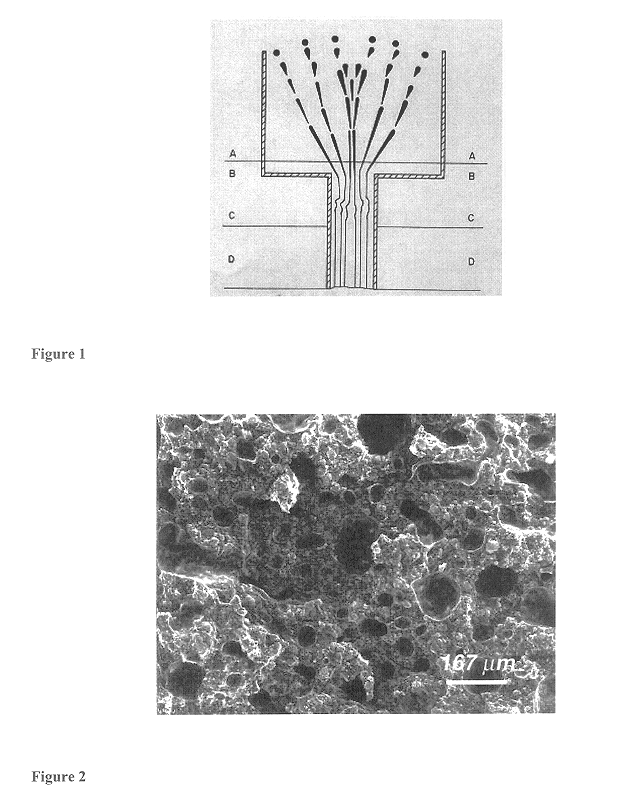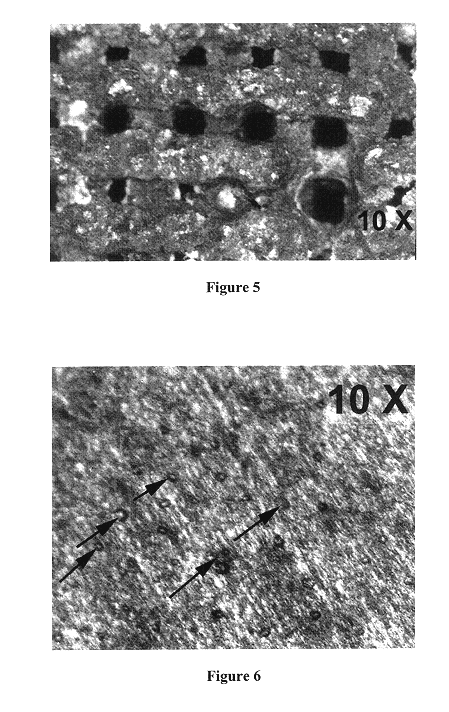Method for preparation of metallic foam products and products made
a technology of metallic foam and products, applied in the field of method for preparation of metallic foam products and products, can solve the problems of difficult control of pore size or orientation using these known techniques, and new manufacturing approaches beneficially affecting performance and cos
- Summary
- Abstract
- Description
- Claims
- Application Information
AI Technical Summary
Benefits of technology
Problems solved by technology
Method used
Image
Examples
example i
This example illustrates a blend formulation that can be used to make metallic foam. As shown in Table I, aluminum powder was blended with copper powder to produce an Al-4 wt % Cu alloy blend. The copper powder was added to the aluminum powder to create an alloy composition that would be more readily sinterable than pure aluminum alone. The aluminum and copper powders were similar in size. The Al and Cu powders were approximately 45 .mu.m size particles, with an average particle size of 10 .mu.M. The polymer (water-soluble) is a multi-component mixture. It was first melted in a Brabender high-shear mixer and the aluminum-copper powder mixture was then added as carefully as possible.
After compressing the composite blend into feed rods, they were extruded at temperatures of about the 225-250.degree. C. Next, the binder burn-out was performed using either flowing nitrogen or flowing nitrogen with 5% hydrogen, followed by furnace cooling. Using this formulation, the cycling binder burno...
example 2
This example illustrates another blend formulation that can be used to make metallic foam. As shown in Table III, aluminum was used as the primary metallic powder with small amounts of Mg and Sn added to the aluminum in an effort to reduce oxide layers formation on the metallic powder. In this example, the composite blend contained 8 wt % of Mg and 8 wt % of Sn. Additionally, Mg and Sn form a eutectic alloy with Al well below the maximum binder burnout temperature, thus allowing the foam material sufficient structural rigidity to be handled between the binder burnout and sintering steps.
This formulation used the polymethylmethacrylate (PMMA) as the polymer binder. Although PMMA has a relatively high viscosity, it was used as the polymer binder because it has clean burn-off characteristics. In this example, the xylene also served to reduce the viscosity of the PMMA.
After compressing the composite blend into feed rods, they were extruded at temperatures of about 225-250.degree. C. The...
example 3
Metallic foam components were made using the formulation in Table IV. The major binder phase was PMMA and the minor binder phase was butyl oleate. The same general procedure as in the previous examples was used with this formulation.
Further, this formulation permitted the use of enhanced extrusion conditions and the use of a smaller extrusion tip with a 0.012" extrusion nozzle. This formulation was successfully extruded at 200.degree. C. and 275-300% flow. This formulation and extrusion conditions provided a smoother surface finish after extrusion.
The burnout schedule, shown below in Table V, was used for this formulation. The burnout was performed in either flowing nitrogen or flowing nitrogen with 5% hydrogen, followed by cooling. The hold times listed in Table V can be adjusted in proportion to the dimensions of the sample.
FIG. 6 shows a longitudinal cross-sectional view of a fully sintered aluminum foam sample according to this example. Dynamic Split Hopkins Pressure Bar (SHPB) ...
PUM
| Property | Measurement | Unit |
|---|---|---|
| diameters | aaaaa | aaaaa |
| internal porosity | aaaaa | aaaaa |
| temperatures | aaaaa | aaaaa |
Abstract
Description
Claims
Application Information
 Login to View More
Login to View More - R&D
- Intellectual Property
- Life Sciences
- Materials
- Tech Scout
- Unparalleled Data Quality
- Higher Quality Content
- 60% Fewer Hallucinations
Browse by: Latest US Patents, China's latest patents, Technical Efficacy Thesaurus, Application Domain, Technology Topic, Popular Technical Reports.
© 2025 PatSnap. All rights reserved.Legal|Privacy policy|Modern Slavery Act Transparency Statement|Sitemap|About US| Contact US: help@patsnap.com



